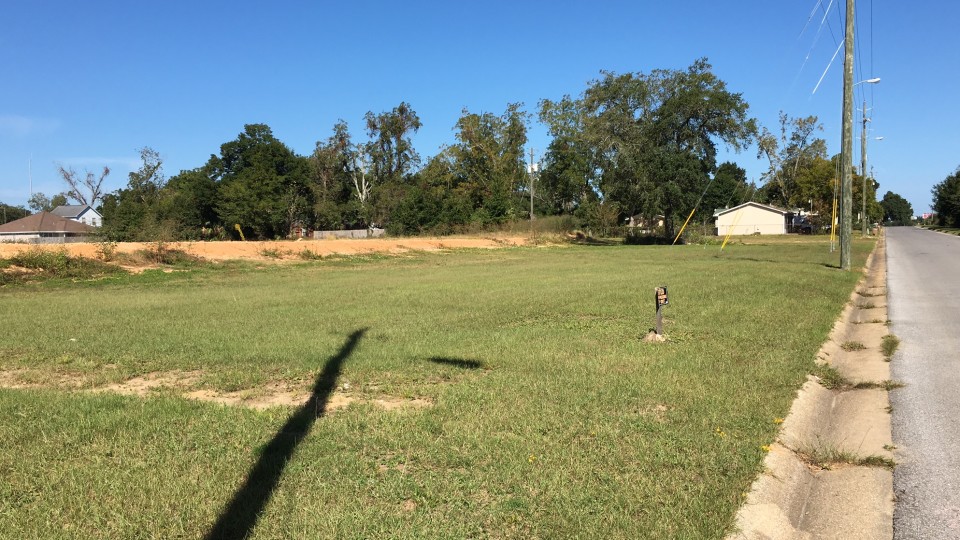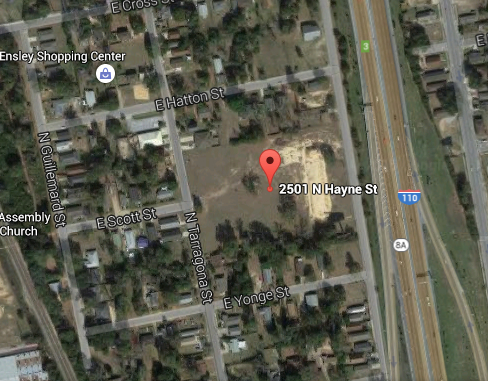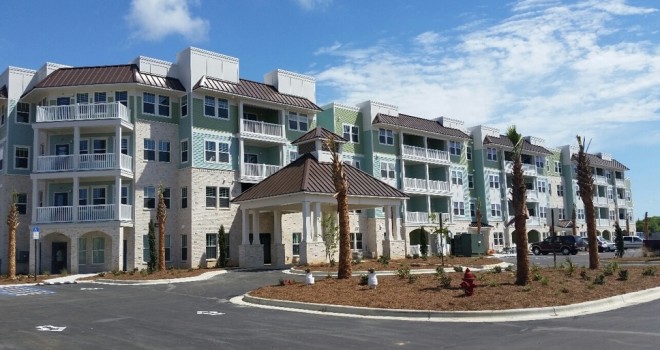Zoning snafu derails Eastside development
- October 19, 2015
- / Shannon Nickinson
- / community-dashboard

This is the site of the former J. Lee Pickens School on North Hayne Street. Photo credit: Shannon Nickinson
A plan for a multimillion- dollar investment in the Eastside neighborhood by a Georgia foundation that builds affordable housing has fallen through.
Paces Foundation, a developer of affordable housing projects in Smyrna, Ga., was under contract to buy from Manna Food Pantries the razed site of the former J. Lee Pickens School at 2501 N. Hayne St.
Rick Haymond, development manager for Georgia-based Paces Foundation, which builds affordable housing for seniors and families.
“We would have liked for the project on Hayne Street to work out,” says Rick Haymond, development manager for Paces. “Unfortunately it didn’t. We really enjoy working in the area, and we’ve had good success there.”
Access to safe, affordable housing in the Pensacola metro area is an issue tied to improving the quality of life and economic prospects in a community. The Pensacola area is 3,000 units short of the demand for affordable housing, according to local experts.
Some 57 percent of the households in Escambia County spend more than 30 percent of their monthly income on rent, according to data from the Studer Community Institute’s Pensacola Metro Dashboard.
Financial experts say that no more than 30 percent of monthly income should go toward housing costs — if it does, the household is considered “rent-burdened.”
The dashboard measures 16 metrics that gauge the economic, educational and social well-being of the community.
While the need for housing is real in the community, several Eastside neighbors at an Oct. 8 Pensacola City Council meeting, said they did not want rental units in an area that is working hard at revitalization.
“That piece of property is a large section of our neighborhood,” Veronica Fountain said at the meeting. “We’d like it to be affordable homes that would bring more families and build our neighborhood back up.”
Eastside making a comeback
The issue arose last week at a Pensacola City Council meeting, where a zoning change for the Eastside neighborhood was being considered.
City Planning Services Director Sherry Morris said that the land development code and the current zoning in Eastside — bordered roughly by Strong Street, Sixth Avenue, up the interstate corridor along Hayne Street to Guillemard to Baars streets — conflict.
That means the area needs to be changed from zoning R-NC, residential neighborhood commercial, to R-1AA, which is one- and two-family residential.
Morris says existing businesses in the area are grandfathered in and can continue their current use as long as that use is continuous.

A Google Earth map of the former J. Lee Pickens School site at 2501 N. Hayne St., Pensacola. Credit: Google Earth
The Paces multi-family apartment complex wouldn’t have complied with the new R-1AA zoning, which brought Haymond to the council on Oct. 8.
It also brought out residents who worried that apartments aimed at low-income renters would degrade the quality of life in the area, which is staging a comeback after years of neglect.
Jeannie Rhoden, who spoke at the meeting, noted that the Eastside Redevelopment Board blessed the new zoning plan.
“We have become more diverse as young families have become homeowners,” Rhoden said. “Wealthy neighborhoods benefit from zoning protections; we should benefit, too. We’re trying to come together as a diverse group of people in our community. We want homes in our neighborhood.”
While some speakers at the meeting did say the area is well-suited to small business development, Councilwoman Jewel Cannada-Wynn said “this is a residential neighborhood, It has all of the elements for that, with one of the largest parks in the city of Pensacola. You have all of the elements to make this neighborhood a place to be.”
Council eventually voted 4-4 on changing the zoning, which means nothing changes and the area remains zoned R-NC.
But Morris says it can’t stay that way.
She will bring the matter to council again in November, when one hopes, council will find a way to make the zoning comply with the requirements of the land development code.
“Zoning and future land use have to match,” Morris says.
Which means either the zoning has to change or the land development code has to change, Morris says. If Council opts to revisit the future land-use map in that area, the matter would have to go back to the Planning Board, then back to council.
“One of those things needs to happen,” Morris says.
Manna seeks new facility
Manna bought the property in 2014 for $125,000 from the Escambia School District. The nonprofit abandoned plans to relocate the main pantry now on Tarragona Street to the old Pickens school site when neighbors objected.
Manna would have to receive approval from the Planning Board and City Council to build a warehouse exceeding 4,000 square feet under the R-NC zoning designation.
Now that plans to sell the 4.5-acre lot toPaces Foundation fell through, Manna is searching for a new warehouse and office space that will accommodate its clients and keep the agency out of flood-prone areas.
The Escambia County Property Appraiser's site lists the assessed value of the land at $50,000.
DeDe Flounlacker, executive director of Manna Food Pantries, said the property will go back on the market. She said both Manna and Paces signed a nondisclosure agreement about the deal, so she could not reveal the price Paces would have paid for the 4.5-acre site.
“They were brought to us as I recall,” she says. “We’re still shopping that (property) around. We’ve looked at 20 different properties so far. We’re still trying to find the right place and a good place for the community.”
Flounlacker says Manna will have to be near a bus stop, because so many clients use public transportation.
“We have such a mixture of what we need in a building,” she says.
This year, 500,000 pounds of food have come through Manna’s warehouse. Manna also needs space to see clients and help them get the services they need.

April flood severely damaged Manna Food Pantries. The nonprofit is again in the market for property to build a new facility. Photo credit: Manna Food Pantries.
“We’ve helped more than 20,000 people this year,” she says. “We’re just looking for a place that will be a good home for Manna.”
Flounlacker and staff have been working out of construction trailers since the April 2014 flooding damaged Manna’s current facility.
Still, they have continued their work, including a program at Westminister Village to help seniors make it through the month with the healthy food they need. The program gives 160 seniors two weeks of food a month. Read more here.
“Our Westminster seniors are seeing better financial stability and better health outcomes because of that partnership, which is great,” Flounlacker says.
Paces future Pensacola plans
Haymond, development manager for Paces, says they had planned a $12 million to $15 million investment in the site, which would have included four buildings of two or three stories.
It featured 76 units from one- to four-bedrooms, aimed at everyone from families to seniors. It would include fitness centers community rooms, computer rooms, after-school programs from children and the like.
The project would not have been subsidized or Section 8 housing. Haymond said Paces would use the federal government’s Low Income Housing Tax Credit program, a competitive program that gives developers credits toward the financing of the project.
“We use the tax credits to keep rents low,” Haymond said.
Paces targets renters who make between 35 percent and 60 percent of the area’s median income. In Escambia County, the median income is $43,918, which means the development would target people who earn between $15,119 and $26,350.

The Paces Foundation's 92-unit project at Park Place and West Herman is 100 percent occupied. Photo credit: Paces Foundation.
Paces’ 92-unit project at Park Place and West Herman is 100 percent occupied. And Haymond said Paces still is interested in the Pensacola market.
Paces has applications with the Florida Housing Finance Corporation for two other projects in Pensacola.
One in Brownsville at W and DeSoto streets at the former Brownsville Assembly of God property would be a senior facility, similar to the one on West Park Place and Herman Street.
A second application is pending for a family development on P Street.
Paces developed Fairfield Manor on West Herman Street, an apartment complex aimed at residents ages 55 and older that is LEED-certified for low-impact environmental design qualities.
They also developed Panama Commons in Panama City.
Hammond said a third-party management company manages their properties. And, he said, while there were public safety concerns when Panama Commons was built five years ago, fears that crime would spread because of the development did not come to pass.
“(At Panama Commons) we’ve had three or four instances in that five-year period where the police have been called and one was a suicide,which no one could do anything about. If we run a bad property we’ll get our credits removed or we won’t have renters.”
 CivicCon launches with a look at good growth in cities
CivicCon launches with a look at good growth in cities
 Building stronger brains one baby, one parent at a time
Building stronger brains one baby, one parent at a time
 SCI debuts commercial on Early Learning City
SCI debuts commercial on Early Learning City
 Entrecon: World class speakers and an opportunity to sharpen skills
Entrecon: World class speakers and an opportunity to sharpen skills
 PYP Quality of Life survey 2017
PYP Quality of Life survey 2017
 EntreCon Pensacola 2016: A look back
EntreCon Pensacola 2016: A look back
 Leadership tip: getting better employee takeaways
Leadership tip: getting better employee takeaways
 Leadership tip: be interested instead of interesting
Leadership tip: be interested instead of interesting
 Leadership tip: delivering difficult messages
Leadership tip: delivering difficult messages
 Brain Bags boost Arc, Early Childhood Court programs
Brain Bags boost Arc, Early Childhood Court programs